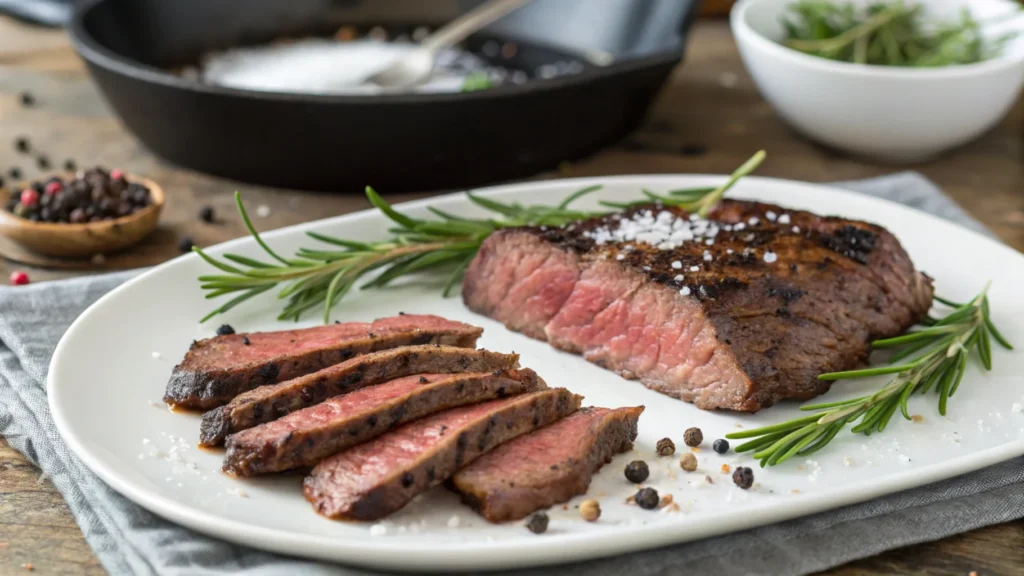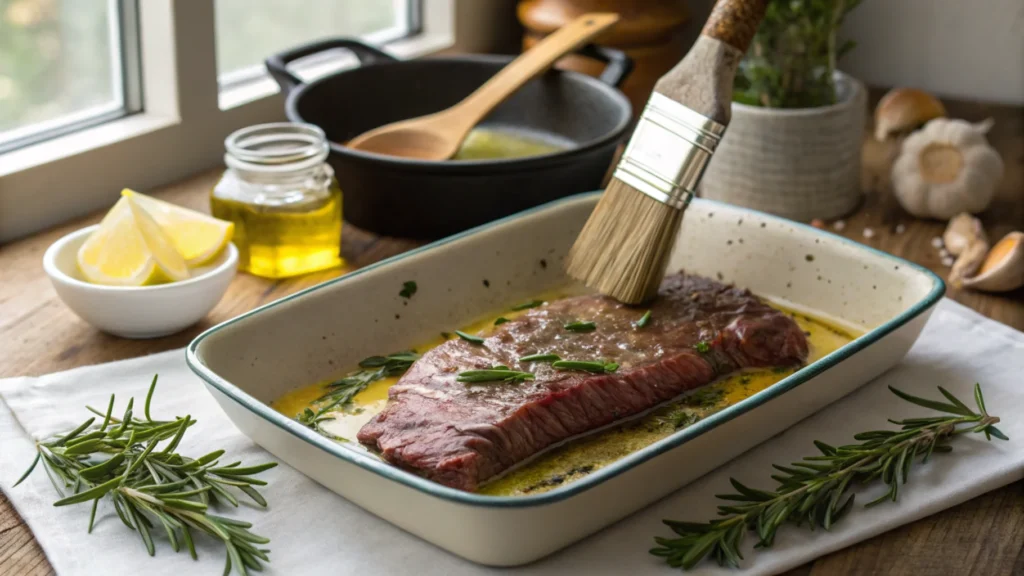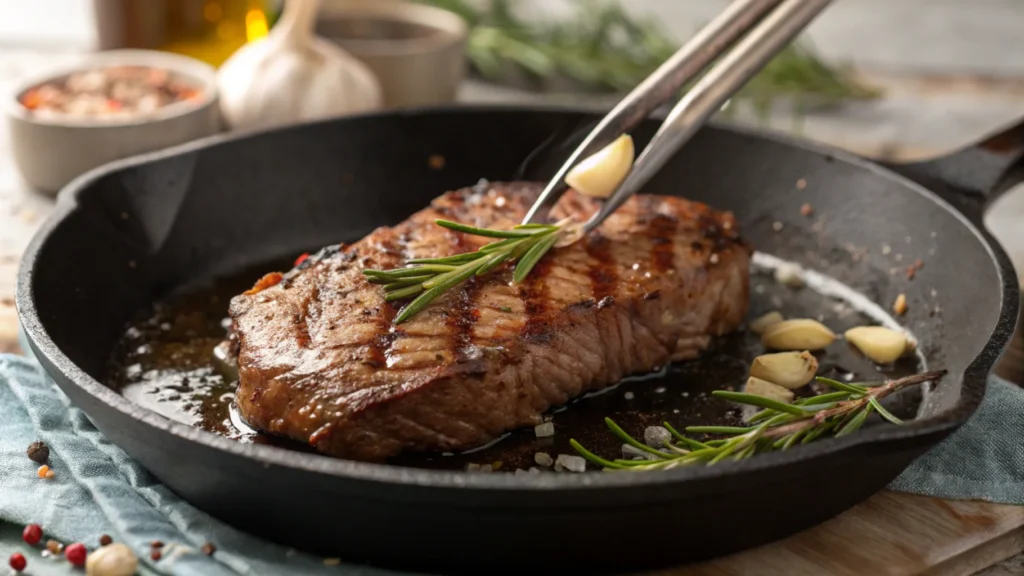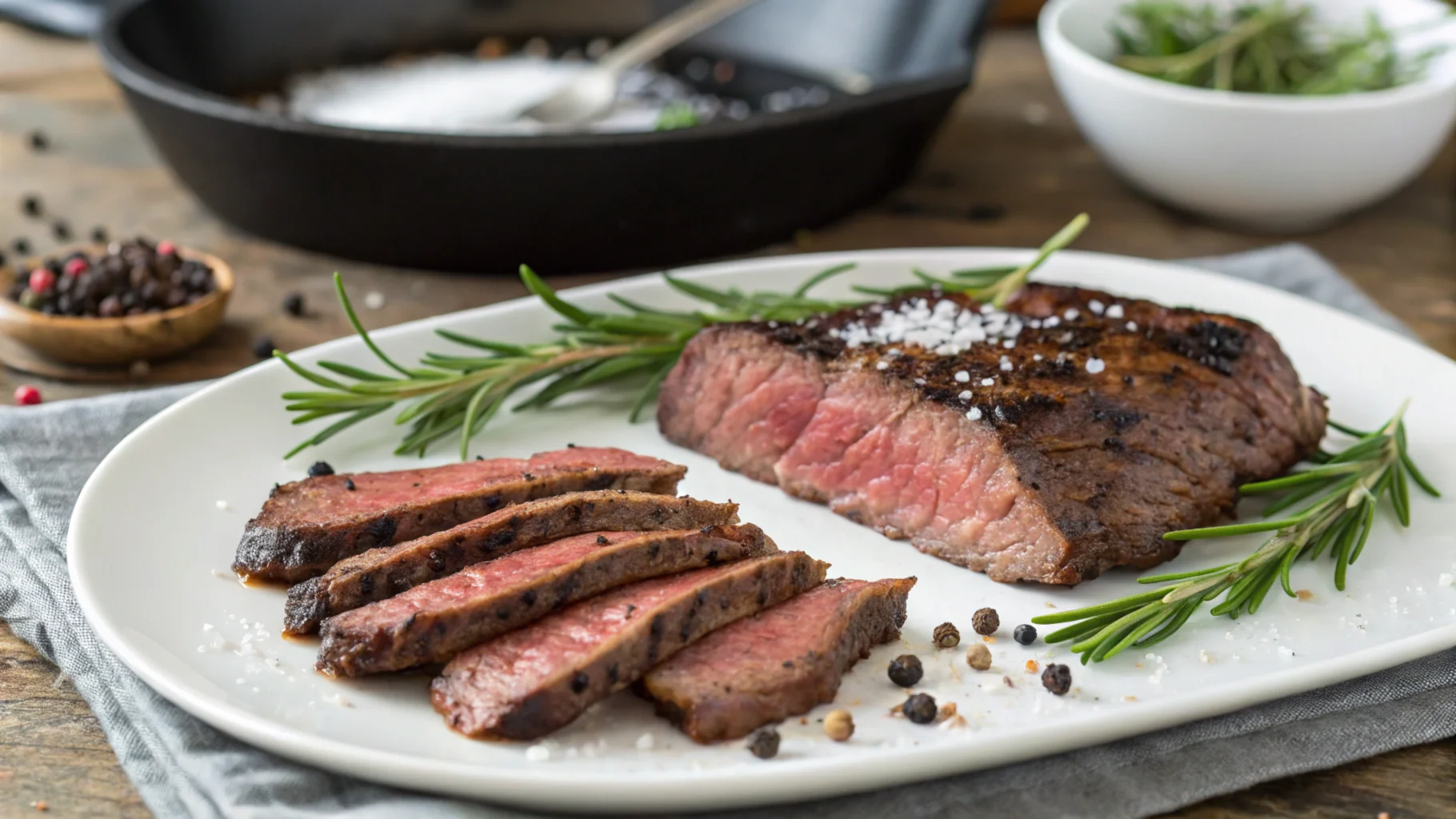Many home cooks are discovering the flat iron steak as an underrated cut. It offers tenderness, flavor, and versatility. How Is Flat Iron Steak Best Cooked? You can prepare it in various ways to suit different tastes, making it an excellent choice. Whether you are an experienced chef or just starting out, learning how flat iron steak is best cooked will enhance your meals. This guide covers everything from selecting the best cut to mastering cooking techniques.
For those looking to expand their culinary skills, exploring recipes beyond steak can be just as rewarding. Check out these chicken thigh recipes for more delicious and versatile meal options.

Table of Contents
Choosing the Best Steak
When selecting the ideal flat iron steak, quality and marbling are key factors to consider. The better the marbling, the more flavor and juiciness you’ll get from the cut. Additionally, choose a steak that’s well-trimmed, has a rich, red color, and feels firm to the touch.
Here are some tips for choosing the best flat iron steak:
- Look for marbling: Well-marbled steaks have intramuscular fat, which melts during cooking, resulting in a juicy and flavorful steak.
- Check the color: A bright, deep red color indicates freshness.
- Consider the thickness: Opt for steaks that are at least 1 inch thick to ensure an even cook.
- Buy from a trusted butcher: A good butcher can help you select the best cuts and ensure they are fresh.
Once you’ve chosen the perfect flat iron steak, the next step is preparing it for cooking.
Preparing Flat Iron Steak
Proper preparation is essential for achieving the best results. From trimming excess fat to marinating the steak, preparation can make a significant difference in the outcome. So, how is flat iron steak best cooked if you don’t prepare it well?
Essential Tools for Cooking Flat Iron Steak
Before you start cooking, it’s crucial to have the right tools on hand. The following tools will make the process smoother:
- Tongs: Essential for flipping and moving the steak without piercing it.
- Meat thermometer: Ensures your steak reaches the desired level of doneness.
- Cast-iron skillet or grill: These provide the best heat distribution for an evenly cooked steak.
- Sharp knife: For trimming and slicing the steak after cooking.
- Cutting board: A non-slip surface for safe slicing.
With the right tools in hand, you can move on to trimming and marinating the steak.
Trimming and Marinating Tips
Flat iron steaks are already quite tender, but trimming any excess fat or silver skin ensures a smoother texture. Marinating the steak, on the other hand, can infuse it with extra flavor and tenderize the meat. Here are some tips:
- Trim the fat: While a bit of fat adds flavor, too much can be chewy and unappetizing. Use a sharp knife to remove any unwanted fat.
- Marinate for flavor: If you choose to marinate, make sure to do so for at least 30 minutes to a few hours to enhance the flavor. Use a marinade with acidic ingredients like apple cider vinegar, lemon juice, or plain yogurt to break down the muscle fibers.
- Pat dry before cooking: After marinating, pat the steak dry with paper towels to ensure a good sear.
Once prepared, you’re ready to move on to cooking methods, which can greatly influence the final flavor and texture of your steak.

Cooking Methods
When it comes to cooking flat iron steak, there are several methods to choose from. The method you choose will depend on your preference for flavor, texture, and convenience. Let’s explore the most popular cooking methods.
- Grilling: Grilling flat iron steak adds a smoky flavor while searing the outside, leaving the inside tender. Preheat the grill to medium-high heat and cook for about 4-5 minutes per side.
- Pan-searing: For a crispy exterior and juicy interior, pan-searing in a hot cast-iron skillet is an excellent choice. Use a little oil or butter and sear for 3-4 minutes per side.
- Oven-roasting: If you prefer a more hands-off approach, you can roast the steak in the oven. Sear it in a hot pan for 2-3 minutes on each side and then transfer to a preheated oven at 400°F for about 5-7 minutes.
- Sous-vide: For an incredibly tender result, sous-vide cooking is a popular method. Seal the steak in a vacuum bag and cook it in a water bath at 130°F for 1-2 hours, then finish with a quick sear in a hot skillet.
Each method offers unique benefits, but all of them can deliver a flavorful and tender flat iron steak if done correctly.

Optimal Cooking Times
The cooking time for flat iron steak varies depending on the method and thickness of the steak. Generally, you cook flat iron steaks to medium-rare or medium, but you can adjust the time to match your preferred level of doneness.
- For medium-rare: Cook the steak for about 3-4 minutes per side (internal temperature of 130-135°F).
- For medium: Cook for 4-5 minutes per side (internal temperature of 135-145°F).
- For well-done: Cook for 5-6 minutes per side (internal temperature of 150-160°F).
Remember, after cooking, the steak will continue to cook a little from residual heat, so it’s important to remove it from the heat just before it reaches your target temperature.
Seasoning and Flavoring
Seasoning is key to enhancing the natural flavor of flat iron steak. The best seasoning balances the steak’s rich, beefy taste without overpowering it. So, how is flat iron steak best cooked when it comes to seasoning? Here’s what you need to know:
- Salt and pepper: The simplest seasoning, but it works wonders. Generously season the steak with kosher salt and freshly ground black pepper on both sides.
- Garlic and herbs: Adding minced garlic, rosemary, or thyme can enhance the steak’s flavor. You can either sprinkle it on before cooking or infuse the steak with these flavors by adding them to the pan during the searing process.
- Spice rubs: For a more intense flavor profile, consider using a spice rub. A mix of chili powder, paprika, and brown sugar can give the steak a sweet and smoky finish.
Feel free to experiment with different flavor profiles, but always ensure that the seasoning complements, rather than masks, the natural taste of the flat iron steak.
Resting and Slicing
Once your flat iron steak is cooked to perfection, it’s important to let it rest before slicing. This allows the juices to redistribute throughout the meat, resulting in a juicier and more tender steak.
- Let it rest: After cooking, place the steak on a cutting board and let it rest for 5-10 minutes.
- Slice against the grain: To maximize tenderness, always slice the steak against the grain. This shortens the muscle fibers, making the meat easier to chew.
By following these steps, you’ll ensure that every bite of your flat iron steak is tender and full of flavor.
Pairing Suggestions
To elevate your flat iron steak experience, consider pairing it with the right side dishes and beverages. Here are some ideas:
- Beverages: A refreshing fruit juice like pomegranate or a sparkling water with a hint of lime pairs wonderfully with the rich flavors of flat iron steak.
- Sides: Roasted vegetables, mashed potatoes, and a fresh salad complement the steak’s savory taste.
- Sauces: Try serving the steak with a tangy chimichurri, a rich béarnaise sauce, or a simple garlic butter.
These pairings can add depth and variety to your meal, making it an unforgettable dining experience.
Common Mistakes: How Is Flat Iron Steak Best Cooked?
Even seasoned cooks can make mistakes when preparing flat iron steak. Here are some common pitfalls to avoid:
- Overcooking: Flat iron steak is best cooked medium-rare to medium. Overcooking can result in a tough and dry steak.
- Not letting it rest: Slicing the steak immediately after cooking can cause the juices to run out, leaving the meat dry.
- Incorrect slicing: Always slice against the grain to ensure tenderness.
- Skipping seasoning: A lack of seasoning can leave the steak tasting flat and underwhelming.
By avoiding these mistakes, you can consistently achieve a steak that is tender, flavorful, and perfectly cooked.
Health Benefits
In addition to being delicious, flat iron steak has several health benefits. It’s a great source of protein, iron, and zinc, which are essential for muscle building, immune function, and overall health. Furthermore, the lean nature of flat iron steak makes it a healthier option compared to fattier cuts of beef.
Here are some health benefits of flat iron steak:
- High in protein: Flat iron steak is a great source of protein, which is important for muscle growth and repair.
- Rich in iron: This cut provides a good amount of iron, which helps transport oxygen throughout the body.
- Low in fat: Compared to other cuts, flat iron steak is relatively lean, making it a healthier choice for those watching their fat intake.
By enjoying flat iron steak in moderation, you can benefit from these essential nutrients while indulging in a delicious meal.
FAQs: How Is Flat Iron Steak Best Cooked?
How is flat iron steak best cooked?
Cooking flat iron steak using methods that create a rich, flavorful crust while keeping the interior tender yields the best results. The most popular methods include:
- Grilling: Provides a smoky flavor with a crispy exterior.
- Pan-searing: Ideal for achieving a perfect sear, usually in a cast-iron skillet.
- Oven-roasting: A good option if you prefer an easy, hands-off method.
- Sous-vide: This method offers an incredibly tender result, followed by a quick sear.
Regardless of the cooking method, flat iron steak is best cooked to medium-rare or medium for optimal tenderness and flavor. Always make sure to let it rest before slicing.
Is flat iron steak better rare or medium?
Cooking flat iron steak to medium-rare or medium generally yields the best results. These doneness levels help preserve its tenderness while ensuring a flavorful, juicy outcome. If cooked rare, the steak may be too underdone for some, and anything beyond medium can result in a tougher, drier texture.
For medium-rare, aim for an internal temperature of about 130-135°F, and for medium, cook to an internal temperature of 135-145°F. These ranges will keep the meat tender and juicy, while still offering a desirable texture.
What doneness is best for flat iron?
The best doneness for flat iron steak is typically medium-rare to medium. These levels of doneness allow the meat to retain its moisture, keeping it juicy and tender. For flat iron steak, which is already naturally tender, cooking it to medium-rare or medium ensures the muscle fibers remain relaxed and the steak remains flavorful.
- Medium-rare: Ideal for juicy, tender steak with a slightly warm red center (130-135°F).
- Medium: Offers a firmer texture with a pink, warm center (135-145°F).
Avoid cooking flat iron steak beyond medium, as it can become tough and lose its delicious flavor.
Is flat iron steak tender or tough?
Flat iron steak is known for being tender despite being a relatively affordable cut of beef. It comes from the shoulder of the cow and is known for its fine grain and even marbling, which contribute to its tenderness. When cooked correctly, flat iron steak can be incredibly juicy and tender, rivaling more expensive cuts like ribeye or filet mignon.
However, like any steak, it can become tough if overcooked, so it’s crucial to cook it to the right level of doneness to preserve its natural tenderness.
Conclusion: How Is Flat Iron Steak Best Cooked?
In conclusion, flat iron steak is a versatile and flavorful cut of meat that can be cooked in a variety of ways, such as grilling or pan-searing, to suit different tastes. Achieving the perfect steak involves selecting a high-quality cut, preparing it with care, and cooking it to the desired level of doneness. Don’t forget to season it properly and let it rest to ensure it remains tender and juicy. Pairing it with complementary sides and beverages can enhance the dining experience further.
To learn more and gain confidence in preparing this delicious cut, check out this comprehensive guide on Flat Iron Steak: A Complete Guide to Cooking, Choosing, and Serving. With these tips and insights, you’ll be well on your way to creating a memorable meal

